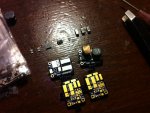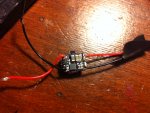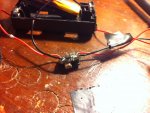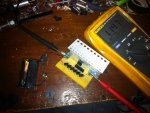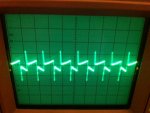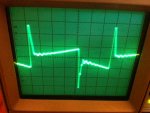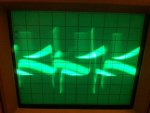I probably won't, but if I ever do an open source buck it would have to be very different from x-drive and blitz buck. I definitely wouldn't want to use the same IC as either of them, and I wouldn't want to steal their business. This driver was made because there were no good alternatives to using flexdrives for single cell builds, and lots of people were using dual flexdrives to get 1.8A. That costs around $60 and the customer service is crappy, so there was a definite need for something cheaper.
I've been playing around with this benboost mini and it works great!
I decided to try a 4.7uh inductor, and it works fine! This would not work before, I suspect it has something to do with the oscillations caused by the ld+/- cap. That cap has been taken out on this version. I am using a 22uf inout and two 22uf between LD+ and ground.
This was a pretty easy board to reflow too. It has a DFN but there is a lot of space between the pins. I think the pitch is 1mm? Its not hard at all, but you have to use the paste sparingly. However much you think it will take use about 1/4 of that!

For the built in heatsink I cut a strip of copper as wide as the heatsink pad from a pre-1982 penny, sanded it shiny, folded it over a few times, and squished it flat. Then I put some solder paste on the heatsink pad and stuck it on just like it was one of the components

I also put a few dabs of paste on the sides to get sucked into the little crevices left from folding it for better heat transfer. It ended up being exactly the same height as the inductor. Its very important that it is at least that tall so you can glue it onto the heatsink in your host.
The board works great:
I ran it for five minutes straight just like that (no extra heatsink) and it never overheated. After five minutes it had dropped to 1.131A because the sense resistors heated up, 16ma lower than where it stated. The input current is also under 2A, about 2/3 of the max. Theoretically we could get another 600ma out of it :eg:, Ill try upping the current later.
I put it on the scope and its not too bad:
AC coupling, each division is 20ma high, 500ns long.
AC coupling, each division is 10ma high, 100ns long.
So the ripple has spikes about 27ma high. Should be safe for any diode we use.
And this is what the waveform looks like when you've ran it so long the battery has drained down to 2.7v and it can't regulated current anymore. It overheated shortly after this. It must have ran at least 10 minutes straight while I was taking pictures and messing around with the scope.
 (x-drive and blitz buck)
(x-drive and blitz buck)




